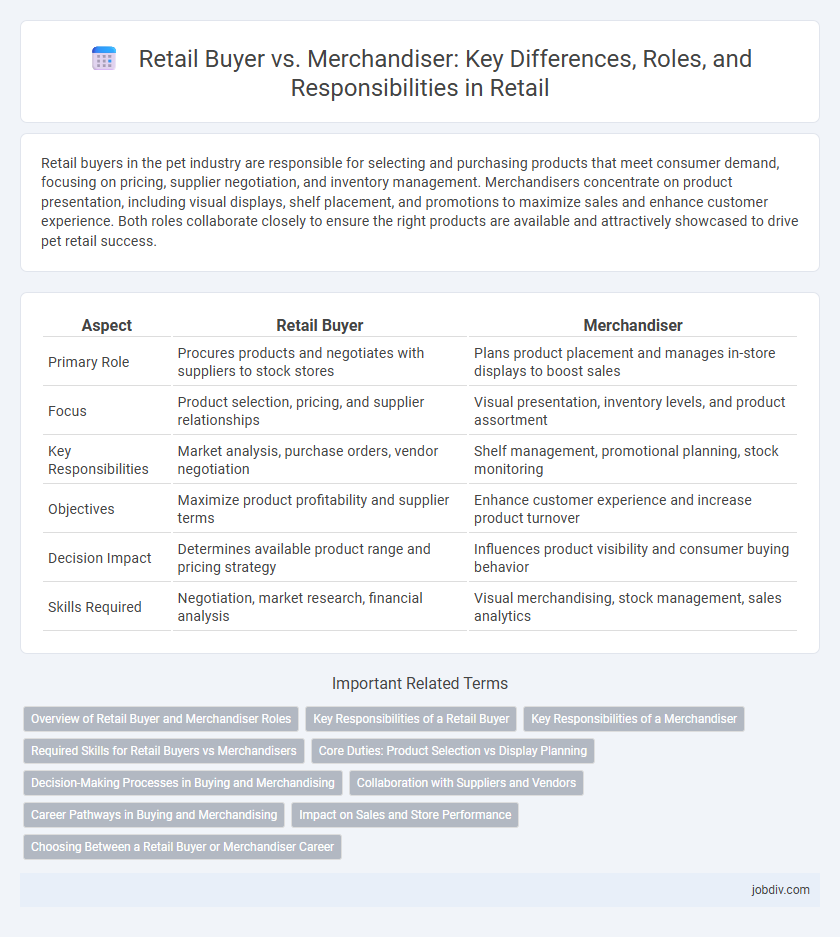Retail buyers in the pet industry are responsible for selecting and purchasing products that meet consumer demand, focusing on pricing, supplier negotiation, and inventory management. Merchandisers concentrate on product presentation, including visual displays, shelf placement, and promotions to maximize sales and enhance customer experience. Both roles collaborate closely to ensure the right products are available and attractively showcased to drive pet retail success.
Table of Comparison
| Aspect | Retail Buyer | Merchandiser |
|---|---|---|
| Primary Role | Procures products and negotiates with suppliers to stock stores | Plans product placement and manages in-store displays to boost sales |
| Focus | Product selection, pricing, and supplier relationships | Visual presentation, inventory levels, and product assortment |
| Key Responsibilities | Market analysis, purchase orders, vendor negotiation | Shelf management, promotional planning, stock monitoring |
| Objectives | Maximize product profitability and supplier terms | Enhance customer experience and increase product turnover |
| Decision Impact | Determines available product range and pricing strategy | Influences product visibility and consumer buying behavior |
| Skills Required | Negotiation, market research, financial analysis | Visual merchandising, stock management, sales analytics |
Overview of Retail Buyer and Merchandiser Roles
Retail Buyers are responsible for selecting and purchasing products that align with consumer demand and business goals, focusing on market trends, supplier negotiations, and inventory management. Merchandisers analyze sales data and customer preferences to optimize product placement, pricing, and promotional strategies within stores to maximize profitability. Both roles collaborate closely to ensure product assortment meets market needs while maintaining cost efficiency and enhancing the customer shopping experience.
Key Responsibilities of a Retail Buyer
A Retail Buyer is primarily responsible for selecting and purchasing merchandise that meets consumer demand, analyzing market trends, negotiating with suppliers, and managing product assortments to maximize profitability. They conduct sales performance analysis and forecast demand to ensure inventory aligns with customer preferences and seasonal fluctuations. Retail Buyers collaborate closely with marketing and merchandising teams to strategically position products and optimize sales channels.
Key Responsibilities of a Merchandiser
Merchandisers analyze market trends and customer preferences to plan effective product assortments and maximize sales potential. They coordinate with suppliers, negotiate prices, and ensure timely stock availability, optimizing inventory levels to prevent overstock or stockouts. Merchandisers also design attractive product displays and promotions to enhance the in-store customer experience and boost brand visibility.
Required Skills for Retail Buyers vs Merchandisers
Retail buyers require strong analytical skills to evaluate market trends and negotiate supplier contracts, along with excellent decision-making abilities to select profitable products. Merchandisers need expertise in visual merchandising, inventory management, and sales data analysis to optimize product presentation and stock levels. Both roles demand effective communication skills to collaborate with vendors and internal teams, but buyers focus more on strategic sourcing while merchandisers emphasize customer experience and product placement.
Core Duties: Product Selection vs Display Planning
Retail Buyers focus on product selection by analyzing market trends, negotiating with suppliers, and choosing merchandise that aligns with consumer demand and company goals. Merchandisers specialize in display planning, designing attractive product layouts and promotional setups to enhance customer experience and maximize sales. Both roles are critical in driving retail success through strategic product assortment and effective visual presentation.
Decision-Making Processes in Buying and Merchandising
Retail buyers analyze market trends, customer preferences, and supplier offerings to make purchasing decisions that align with sales targets and inventory goals. Merchandisers focus on product presentation, pricing strategies, and inventory allocation to optimize shelf space and enhance customer experience. Both roles utilize sales data and consumer insights, but buyers prioritize sourcing decisions while merchandisers emphasize visual layout and stock management.
Collaboration with Suppliers and Vendors
Retail buyers collaborate closely with suppliers to negotiate prices, secure product availability, and ensure timely delivery, directly influencing inventory levels and store profitability. Merchandisers work with vendors to develop product assortments, plan in-store displays, and analyze sales data to optimize shelf space and enhance customer experience. Effective collaboration between buyers and merchandisers with suppliers and vendors streamlines supply chain operations and drives retail success.
Career Pathways in Buying and Merchandising
Retail buyers focus on selecting and purchasing products that meet consumer demand and align with market trends, often progressing into senior buying or category management roles. Merchandisers concentrate on product presentation, inventory management, and sales optimization, with career advancement into visual merchandising management or merchandise planning leadership. Both pathways require strong analytical skills and industry knowledge, offering opportunities to specialize in areas like digital merchandising or global sourcing.
Impact on Sales and Store Performance
A Retail Buyer directly influences sales by selecting products that meet customer demand, ensuring optimal inventory levels, and negotiating competitive prices. Merchandisers impact store performance by developing effective product displays, optimizing shelf placement, and analyzing sales data to enhance product visibility and turnover. Both roles are crucial, with buyers driving product selection and profitability, while merchandisers boost customer engagement and store aesthetics to maximize sales potential.
Choosing Between a Retail Buyer or Merchandiser Career
Choosing between a retail buyer and merchandiser career depends on your skills and interests in product selection versus product presentation. Retail buyers focus on analyzing market trends, negotiating with suppliers, and purchasing products that meet customer demand, requiring strong analytical and negotiation skills. Merchandisers concentrate on visual display, inventory management, and sales optimization, demanding creativity and attention to detail to enhance the shopping experience and maximize revenue.
Retail Buyer vs Merchandiser Infographic

 jobdiv.com
jobdiv.com